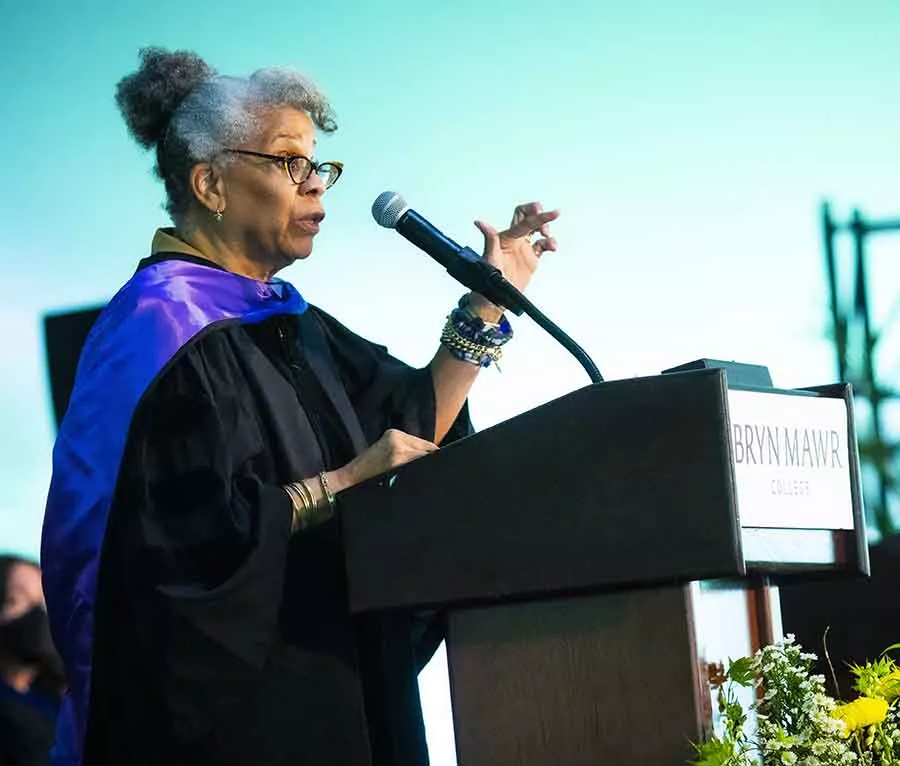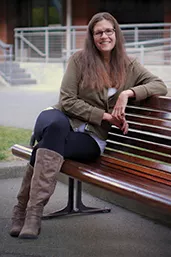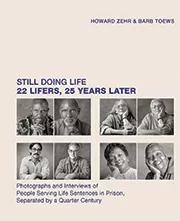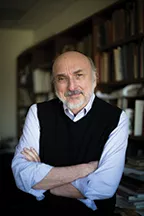For Starters
Activating the archives, life without parole, coming up roses, and more.
1. Everything’s Coming Up Roses!
Bryn Mawr’s entry in this year’s Philadelphia Flower Show, on the theme of “Grounded,” won a blue
ribbon as the Pennsylvania Horticultural Society Garden Class winner.
The College has been part of the Flower Show since 2020, when Lisa Armstrong, associate director
of volunteer programs, connected Daisy Shepherd ’22 and Shirin Sabety ’22—students active in the Bryn Mawr Community Garden—with Dawn DiGiovanni, the campus’s associate director for grounds.
The team’s goal, says Director of Civic Engagement Ellie Esmond, was to create a garden that integrated the idea of wellness and engaged each of the five senses.
“We had strawberries and herbs for taste,” says Esmond, “roses—and other fragrant flowers—for smell, a bubbling fountain for sound, lush grass underfoot for touch, and a beautiful combination of colors and greenery for sight. We envisioned a garden that would provide a respite from a busy life, a place to engage in your senses and find peace.”
2. “A Time of Change”
Nineteen sixty-eight was very much like the present, a turbulent time, a time of change, a time of questioning, and a time of reckoning. ... And unfortunately, we are in fact asking some of the very same questions and fighting some of the very same battles all over again. Like your generation, we were a generation that questioned, that examined, that sat in, that challenged, and that transformed the country in many positive ways. You are in very, very, very palpable ways our progeny.”
— Author and Historian Jessica B. Harris ’68,
2022 Undergraduate Commencement Speaker
3. Thoughts and Prayers
“As someone who writes regularly about prayer, every time I see ‘thoughts and prayers’ in my Twitter feed or hear it uttered by a politician on the news, I wonder what we think we’re praying for.” — Professor of Chemistry Michelle Francl in The Philadelphia Inquirer, May 26, 2022, following the shooting at Robb Elementary School in Uvalde, Texas
4. Doing Life
How do prisoners serving life sentences give their lives purpose and hold onto hope in the face of seemingly insurmountable odds? Some answers to that question can be found in Still Doing Life: 22 Lifers, 25 Years Later, a newly published book by GSSWSR alumna Barb Toews, Ph.D. ’14 and Howard Zehr.
The book features portraits and interviews with 22 men and women serving life in Pennsylvania prisons without the possibility of parole. Zehr, a restorative-justice expert, took the photographs (two of each lifer, 25 years apart) and carried out the interviews. Toews, an assistant professor of criminal justice at the University of Washington, Tacoma, wrote the introduction and accompanying essays.
For the lifers in the book, “glimmers of hope” take many forms, Toews says. “Giving back is a huge theme—helping younger people when they come into prison, trying to keep people from coming back in.” Many, she says, become involved in healing work.
The book’s purpose, Toews says, is to start a dialogue, humanize the people in the book and get readers thinking about what a life sentence means and whether it is achieving what we want in society.
5. Power Dynamics 101
Bryn Mawr’s faculty have approved a new Power, Inequity, and Justice requirement that will be in place when the Class of 2027 arrives on campus in August 2023.
“Our curriculum needs to foreground more explicitly a basic ethical component of a 21st-century education: an understanding of the ways that power dynamics and hierarchies shape the production of knowledge and access to opportunity, as well as engagement with histories and futures of social transformation and justice,” wrote the members of the Curriculum Committee in their proposal to the faculty.
The committee acknowledged the valuable teaching, research, and learning already happening on campus and expressed the hope that the new requirement would “recognize, support, and build on that ongoing work, while articulating priorities around which further support can be provided to faculty and students to creatively, productively, and collaboratively explore these issues.”
6. Activating the Archives
Seymour Adelman Director of Special Collections Eric Pumroy retired in July after a 23-year career at Bryn Mawr. He recalled some highlights:
Proud moments: When I came here, there was a feeling that this was kind of a musty old collection. I think we’ve activated it, and we’ve supported students with some serious efforts to look at our history, including the Black at Bryn Mawr tour and Who Built Bryn Mawr?
Important acquisitions: The children’s book collection was the single biggest acquisition during the time I’ve been here. We’re at about 12,000 books now, and they get used really heavily. At least 10 classes last year
made significant use of them.
Bryn Mawr students: They’re a very serious group. In 1999, I put an internship program in place, and for the last 21 years we’ve had interns every summer working with the collections. They’ve been a consistently very smart, very self-starting group that asks good questions and really are a joy to work with.
7. Artist, Teacher, Mentor
“Enrique Sacerio-Garí has enriched Bryn Mawr College as a Caribbean cosmopolitan scholar-artist, a teacher and mentor, an institution builder, and a great friend,” said Professor of Political Science Michael H. Allen at a spring celebration to honor the Dorothy Nepper Marshall Professor of Hispanic and Hispanic American Studies, who retired this spring after 45 years at Bryn Mawr. “Enrique’s scholarship and art brought Iberian and Anglophone worlds together. He interpreted the Caribbean to the world and the world to the Caribbean.”
As President Kim Cassidy noted at the event, “Enrique’s passion for supporting and mentoring his students is never far from his mind and heart, and I know firsthand that he has changed the lives and trajectories of countless Bryn Mawr students.”
Published on: 08/09/2022




